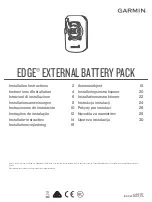
Page 2 of 8
Model:
BMPPT1500
1500W Solar Battery Charger
Booster Maximum Power Point Tracker
Operating Instructions
Please read these instructions before use
Unit 2, 110 Station Road, Seven Hills ,NSW, 2147, Australia
BMPPT1500-R1
Important notes:
•
The panel open circuit voltage MUST be below 27V on battery systems or below 54V on 48V
battery systems.
•
Use only sealed or vented 24V or 48V lead acid batteries and confirm the BMPPT settings,
charge voltages and currents are correct for your battery system – if in any doubt seek
qualified advice!
•
This equipment must be installed by qualified personnel only and incorrect wiring can cause
fire, injury or death – GSL will accept no responsibility for BMPPT misconnection or misuse.
•
Use wires suitable for at least 40A, but if wire runs are over 3m then larger wires are
recommended to limit voltage drop and losses.
•
Install the unit in a dry place out of direct sunlight and away from flammable liquids or gases.
•
Battery fuse ( BF ) is always required and must be located as close to the battery as possible,
its sizing depends on the wire size and load ratings. Typically a 40A 60VDC fuse would do.
•
The lowest Maximum Power Point reqired for proper operation is 14V.
BMPPT1500 Specifications
Efficiency typical
96%
Input voltage
14V to 54V
Output voltage
Float
27V / 54V
Absorption
- Vented LA Batteries
29V / 58V
Sealed - LA Batteries
28.4V / 56.8V
Output Current
26A @ V
out
/ V
in
≈ 2 , 13A @ V
out
/ V
in
≈ 4
Quiescent current
0.04A (0.08A with MCM)
Thermal protection
Multilevel Type
Dimensions (mm)
220 X 145 X 67mm
Indications
LED display – OUTPUT STATUS
BMPPT1500 General Information:
•
Green LED On – Battery Ok.
•
Green LED Flashing – Battery Low.
•
This MPPT is designed to auto detect 24V or 48V battery systems and select a suitable charge
regime.
•
The BMPPT1500 is shipped in a sealed battery setting which is the safest setting but if your
batteries are vented then,
BEFORE
wiring the BMPPT in, follow the
CHANGING BATTERY TYPE SETTING PROCEDURE.
•
The absorption phase is entered following a low battery condition or dawn and is
maintained until the battery demand falls below 1.5A.
•
Custom float and absorption voltages and thresholds are possible but minimum orders apply.
•
This BMPPT has a built in multilevel over temperature protection to improve product reliability
while maximising output power availability.


























